A deep-dive into ØTTA’s ‘Silence Is Oppression’: why did a little known hardcore techno track become a Polish protest anthem?
How an obscure track on a French label became the anthem of Poland’s pro-choice protests…
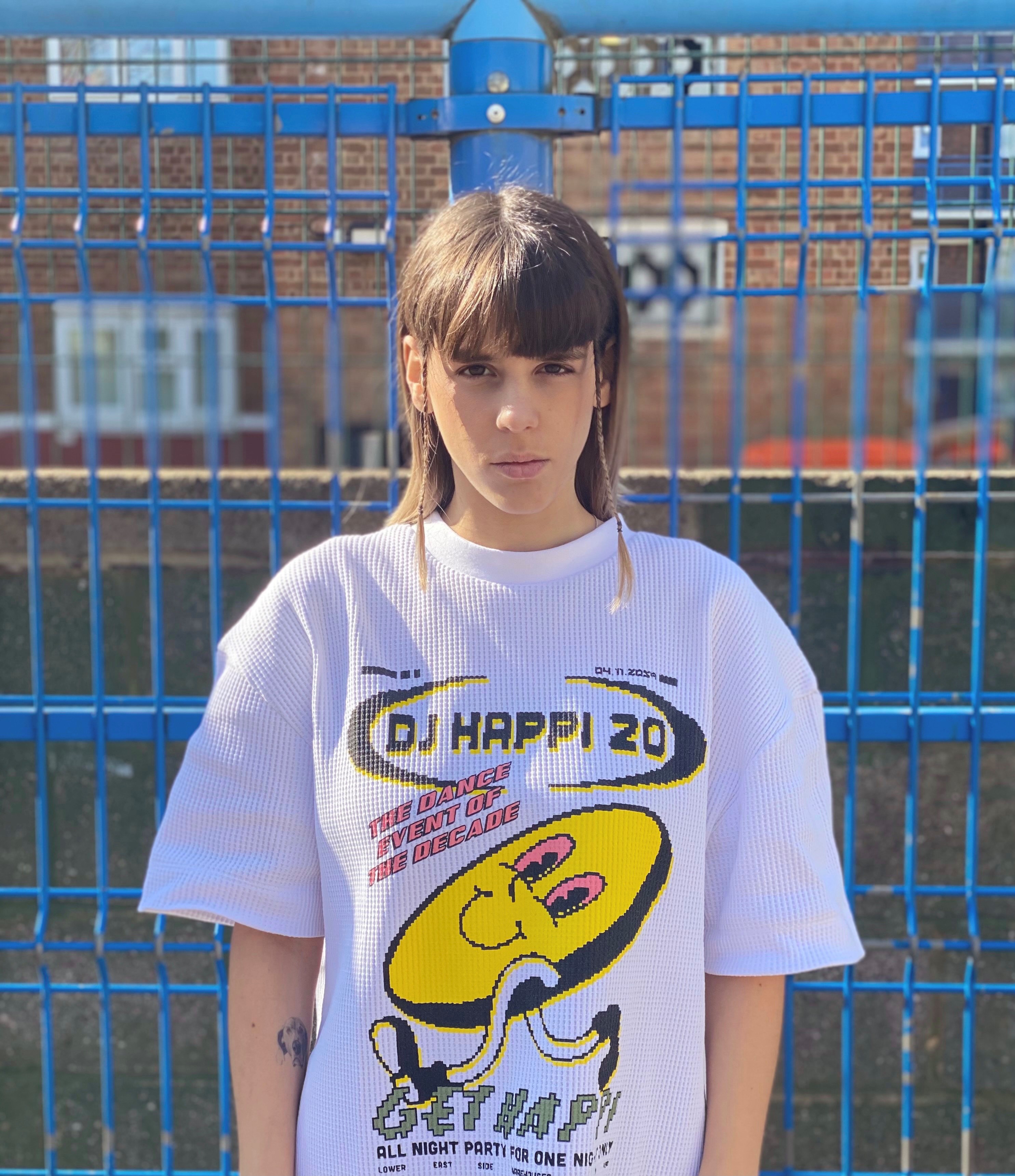
ØTTA
Techno, from its early days, has always coincided ideas of liberation, protest, and political revolution. When the name ‘techno’ streamlined in the late ‘80s, it had reached Detroit, where it became a definable genre label and took on an increasingly subversive aesthetic.
Around that time, Detroit natives Mike Banks, Jeff Mills and Robert Hood formed their label Underground Resistance. With stark reds, blacks and oranges adorning their inner labels and vinyl sleeves, their music took on a distinctly black militant, anti-corporate political aesthetic, with releases such as ‘Riot’, ‘Message To The Majors’ and ‘Revolution For Change’ complemented by a more abrasive, industrial four-to-the-floor sound.
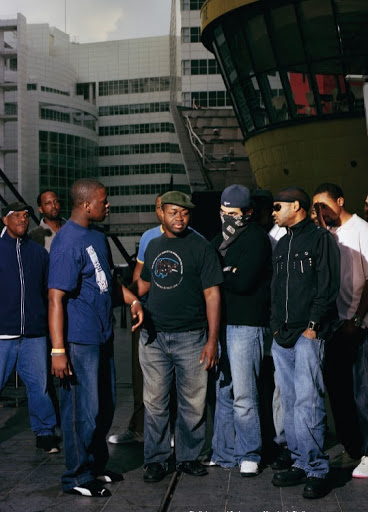
Underground Resistance in The Hague, September 2007. (from left) Ray 7, DJ Skurge, De’Sean Jones, William Pope, Atlantis, Esteban Adame, Stevie Bee, Juan Atkins, Mark Taylor, John Nance.
UR’s artistic statement was not arbitrary. It came in response to economic stagnation and wealth inequality in Detroit, influenced, among other causes, by sloppy Federal Reserve regulations under then-President Ronald Reagan. Poor, African American men, suffering a crisis of identity and survival, were a misplaced scapegoat for the city’s problems. And, for that reason, poor, African American men became UR’s target audience. Banks, Atkins and Mills wanted to provide an alternative space for these indivuduals, having felt long locked out and alienated from an ‘American Dream’ which could only manifest in their musical imaginings, not reality.
The recognition of techno as a genre of black origin, and its proliferation as a rallying cry against oppression, is not uniform in dance music however. Renaat Vandepapeliere, for example – CEO of the internationally-renowned Belgian techno label R&S Records – caused a stir after being accused of racial discrimination in his choice of new signees, as well as allegedly claiming techno’s history to be “very white”, during a feud with former employee and DJ Raji Rags.
On the other hand, popular recognition for techno’s hand in emancipatory struggle has grown in recent years. One such example is Speaker Music’s 2020 surprise album ‘Black Nationalist Sonic Weaponry’, in which the artist – real name DeForrest Brown Jr. – subverts and revises musical narratives around techno, soul, jazz and funk, channelling the experience of collective trauma in the wake of George Floyd’s death in May of that year. Blending noise, hard dance and spoken word, the album was championed by Pitchfork as successful in its mission to “make techno Black again”, railing against the common caricature of techno as soulless, 4×4-kick wallpaper muzak for drug-fuelled all-nighters.
For London resident, Portuguese-born DJ and producer ØTTA – Detroit is, physically, miles away. But for her, it doesn’t feel that way. Nor does her relation to emancipatory struggle through music feel arbitrary. After completing her Master’s Degree in Architecture, she moved to London in 2015, where she enrolled at Point Blank Music School and abandoned her classical music background in favour of making abrasive, dark techno. She soon joined the Орфей (Orpheus) collective, staging nights in warehouses and which invited a range of hardcore techno DJs she knew and loved, and which became known for a riotous, distorted and raw sound.
As a DJ, ØTTA’s repertoire of past performances is plentiful, but her production output is sparse by comparison. As of this article’s writing – besides a collaborative EP with fellow Londoner P RISCO – only two of her tracks are listed on Discogs. One, ‘The Future Is Female’, saw a release on Italian duo 999999999’s imprint NineTimesNine, for a digitally-released compilation, ‘Diavoli’.
The other, ‘Silence Is Oppression’, appeared on ‘EP5’, a 12” compilation EP by Parisian techno collective Possession. Along with tracks by Antigone, Rikhter and Mayeul, ‘Silence Is Oppression’ appeared as a pummelling, claustrophobic hard dance track, replete with crunching leads and all-encompassingly hard kicks. With lyrics co-written by ØTTA and her friend KIXTTEN, it features militantly chant-like vocals, which easily enthrall – “No silence / No racism / No sexism / LGBT / Trans family”.
Swept up in the London scene, it would have been all too easy for ØTTA to give into the comfortable life of a successful DJ, hopping from gig to gig without a second thought for the struggles of elsewhere. But in fact, most of her music is inspired by, and responds to, today’s all-too-pressing movements against racism, sexism and bigotry, which she believes nobody with a public profile should ignore.
Much like Speaker Music’s album, ‘Silence is Oppression’ was inspired by the ongoing Black Lives Matter protests which gained rapid traction after the killing of George Floyd. As she explains, “the fight against discrimination made me think that every person that is lucky enough to have any kind of platform should use it to spread awareness. I started ‘Silence is Oppression’ with the thought of finding a voice through music, and to pass a message of empowerment to all minorities. One of the track’s lyrics is actually “equality for all minorities” – being the women, the LGBTQI + community and all those who suffer from racial discrimination.”
Meanwhile, a completely separate issue to the BLM protests had arisen in Poland. Coinciding with ‘EP5’, in October 2020, a Polish court ruled a near-total ban on abortion, despite the majority of Poles opposing the law. The ban, which only allows abortion in cases of rape or incest that threaten the life of the pregnant person, sparked widespread controversy. It deemed abortions due to severe foetal abnormalities unconstitutional, despite the fact that, in 2019, 98% of abortions were enacted for this reason.

Protestors in Warsaw, January 2021
Despite its ruling in October, the law only came into enforcement in January. That Wednesday, many Poles took to the streets of Warsaw, demonstrating against the conservative government’s political alignment with the Catholic Church. The response was so heated that COVID restrictions were broken. However, protests had been taking place since October, and were nothing new by the end of 2020. Known simply as the ‘Womens’ Strike’, activists have since called for a second round of protests this week, coinciding with International Women’s Day on March 8th.
BLM was the inspiration for ‘Silence Is Oppression’, but the track’s non-specific and all-encompassing lyrics would prove rewarding. One day in October, she checked her phone, discovering that she had been sent some messages by fellow DJ Eta Hox, based in Kraków. To her surprise, the messages contained videos of the Polish protesters, stomping and chanting along to ‘Silence Is Oppression’, visibly enthralled by the track’s sudden four-to-the-floor beat drop. Hox, who had been playing music at the protests, had chosen to play ‘Silence Is Oppression’ through the soundsystem one day, and instantly sensed a shift in the crowd’s mood.
Gleeful, ØTTA posted the video to Instagram, where it went viral, amassing over 10,000 plays, as well as congratulations from friends and fellow DJs. She later described it as an emotional moment. “‘Silence Is Oppression’ was played as an anthem and I couldn’t feel more honoured and happy that it was used in order to support the women in Poland. As a woman myself I relate even more to the cause, and they have my full support. It was the perfect fit.”
Since the track was played at the protest, it has become an underground hit, amassing over 24,000 plays on Spotify alone, far ahead of her peers on the Possession 12”. But, as of late, ØTTA and UR aren’t the only dance music acts to have had their music take popular stock as protest music. In 2020, a collective of Japanese techno and electro artists including Mars89, JACKSON kaki, Miru Shinoda and MC ONJUICY became locally notorious for agitating a crowd outside Shibuya Station in Tokyo, channelling their own original music through a truck-loaded soundsystem in protest against the current Japanese government’s lack of provision for the arts during the pandemic. Likewise, Washington-based electronica artist Bernard Fairey, aka. Outputmessage, set up Black Techno Matters in 2020, an events-based initiative to help black and queer communities and artists; their most recent events series featured live hardware jams at protests throughout Washington.
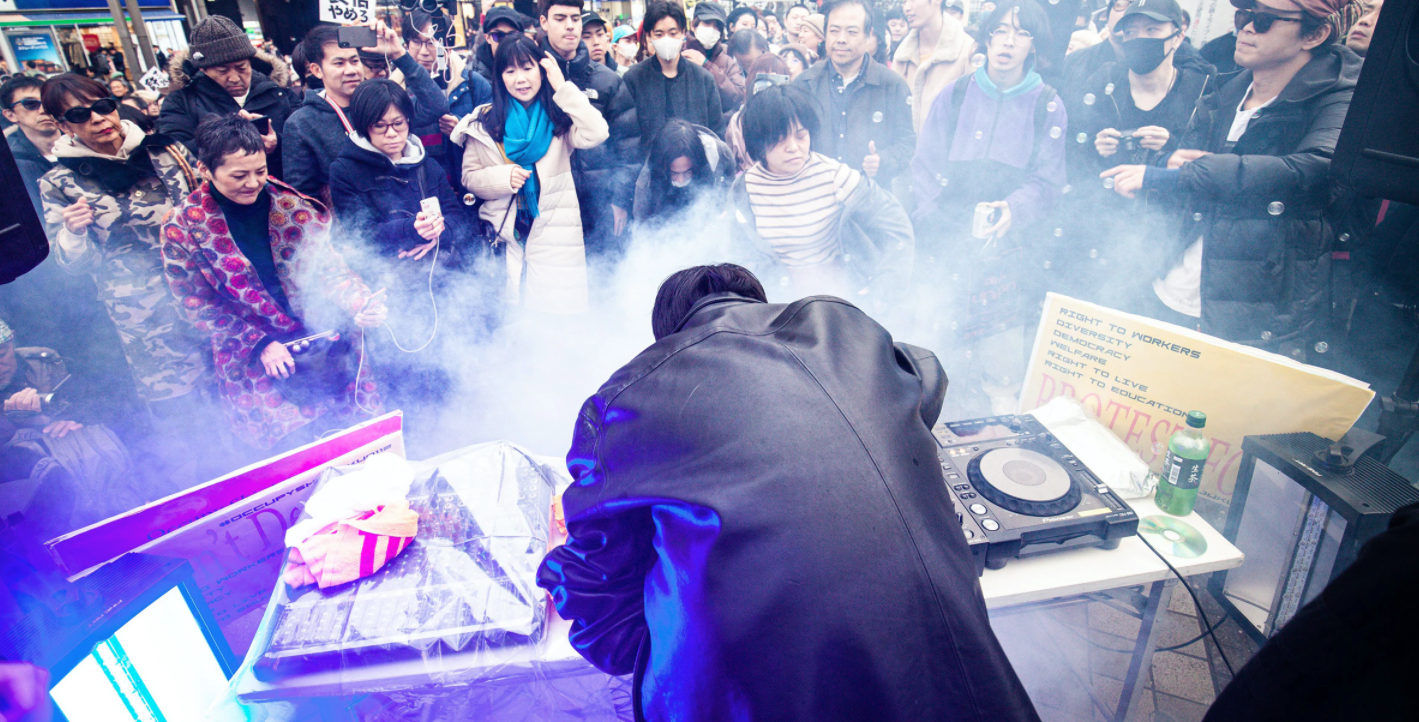
Tokyo’s ‘protest rave’, March 2020
The psychological relationship between hard, bass-heavy dance music and political upheaval is not popularly understood. However, one academic theory, if taken at face value, might not only explain the vigorous fan reaction to ‘Silence Is Oppression’, but might also serve to explain UR and Speaker Music’s adoption of militant themes for their music.
In 2010, producer and Hyperdub founder Steve Goodman aka Kode 9, wrote Sonic Warfare: Sound, Affect and the Ecology of Fear. Published by MIT Press, Sonic Warfare explores the deployment of heavy-hitting bass sounds as psychological weapons in military contexts. The book is laden with neologisms and complex terms like “amodal perceptions” and “rhythmachines”, but, read carefully, it does propose a theory behind why hard-hitting music can trigger coordinated public responses. Put simply, Goodman claims, loud bass frequences did not occur normally in the natural environment from which humans evolved. As a result, they now trigger an instinctive “amodal” reaction, causing the human brain to anticipate an unusually large and dangerous threat producing the sound. This subconscious anticipation, in turn, motivates listeners to react quickly by making pronounced bodily movements, be they running away, fighting, or gesticulating towards the threat. In controlled settings – in which the bass sound is heard as part of a piece of music – this reaction can become dancing, which is associated with collective action.
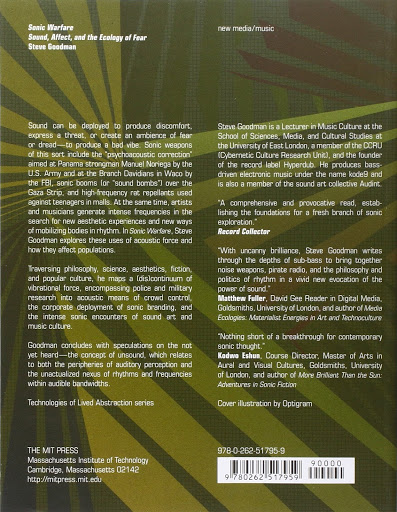
‘Sonic Warfare’ back cover, detailing military applications of bass sound for “mobilizing bodies in rhythm”
This is precisely where Underground Resistance comes in. As ØTTA suggests, it is no coincidence that their music drew on such staunchly militant, deeply-rooted psychological motifs. In an email exchange with Juno, she recalls some text found in the liner notes of one of their releases, ‘Revolution For Change’, which, like Goodman’s theory, speaks of bodily movement, deep frequencies, and primitive natural environments:
“Underground Resistance is a label for a movement. A movement that wants change by sonic revolution… By simply communicating through sound, techno has brought people of all different nationalities together under one roof to enjoy themselves. Isn’t it obvious that music and dance are the keys to the universe? So called primitive animals and tribal humans have known this for thousands of years! We urge all brothers and sisters of the underground to create and transmit their tones and frequencies no matter how so called primitive their equipment may be. Transmit these tones and wreak havoc on the programmers! Long live the underground.”
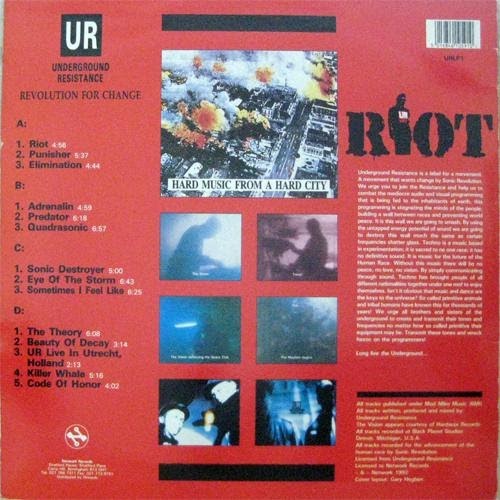
Underground Resistance’s ‘Revolution For Change’ back cover, including liner notes (right) detailing their manifesto
ØTTA is careful not to suggest that ‘Silence Is Oppression’ has exactly the same message as UR, but recognises that the intrinsic sonic parts of techno are their common thread, and that techno itself, despite regularly adopting mechanistic and futuristic themes, calls on a human, primitive urge to action. “I don’t want to compare ‘Silence is Oppression’ with UR, but the track was made with the same order of ideas, with the need of making a difference and fighting for a voice, for a change. Techno is a music based in experimentation; it is music for the future of the human race. Without this music there will be no peace, no love, no vision.”
For those who loved ‘Silence Is Oppression’, ØTTA has since made several other politically-charged tracks. One unreleased piece of hers, ‘Rethink, Reform, Revolt’, was written in response to the UK chancellor Rishi Sunak’s assessment of the creative sector’s viability during COVID-19 lockdowns, as well as a controversial series of posters by the UK government urging those in the arts (as well as other industries) to “Rethink, Reskill, Reboot”.
Many creatives thought Sunak’s comments, heard in an ITV interview – “Plenty of music lessons are still carrying on… in my household and elsewhere” – to be dismissive. Likewise, the portrayal of ‘Fatima’, a dark-skinned ballet dancer on one of the government’s posters, gave many the impression that minorities should refrain from arts careers, and instead seek jobs in “cyber”.

ØTTA describes another track of hers – the aforementioned ‘The Future Is Female’ – as a “scream for attention and a fight for gender equality.” This track also thematically foreshadows the upcoming release of her new EP, ‘Womxn’, slated to be released via Possession this coming May. With its four track titles each referring to a different stereotype for women in contemporary Western society – ‘The Holy Jane’, ‘The Drama Queen’, ‘Old With Cats’ and ‘Single And Fab’ – she uses techno to criticise and deconstruct many of the harmful stereotypical roles ascribed to women who display certain characteristics.
Concluding our exchange with a statement of solidarity, ØTTA expresses pride at the use of her music in political environments. After the popularity of ‘Silence Is Oppression’ in Poland, she vows to continue making music with such a focus. “I believe that the way to rebuild the dance music scene, post-COVID, is to stick together and fight for what we believe in. Meanwhile, I will keep developing my work with the principle of having a voice.”
Jude Iago James